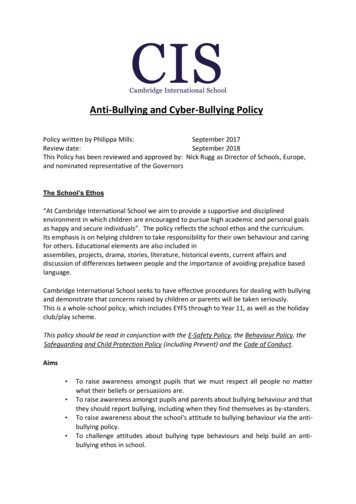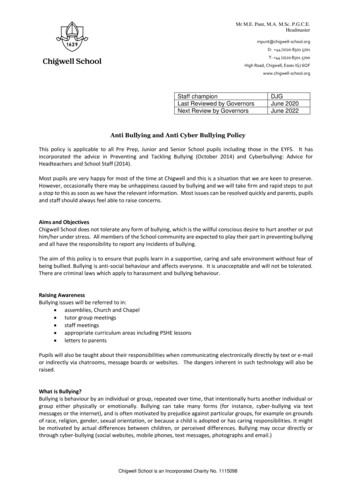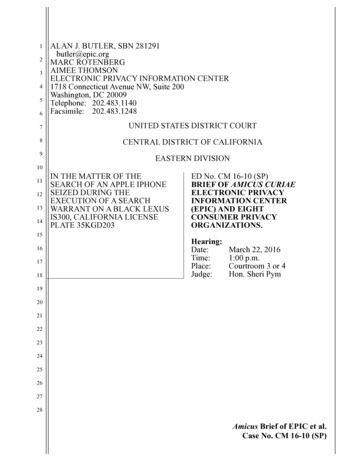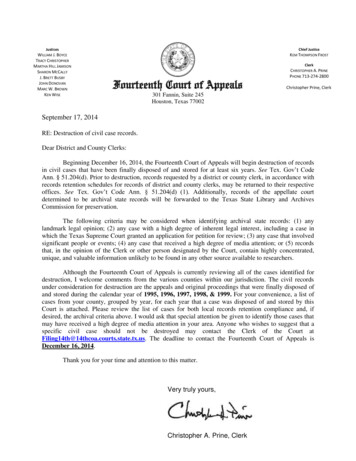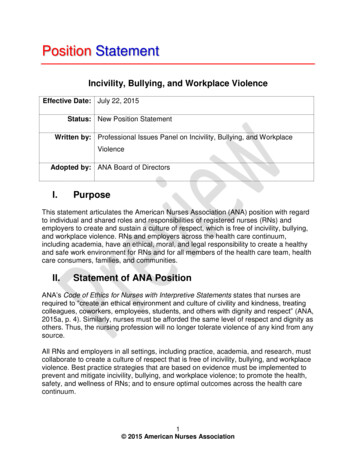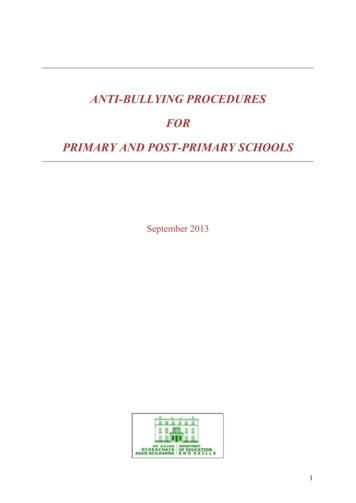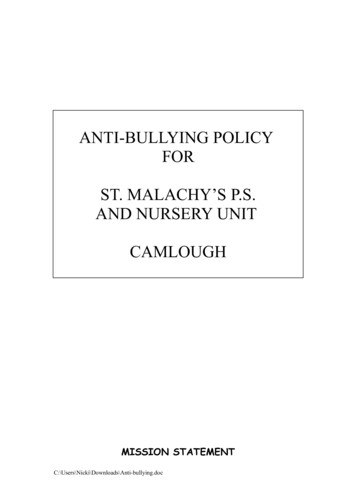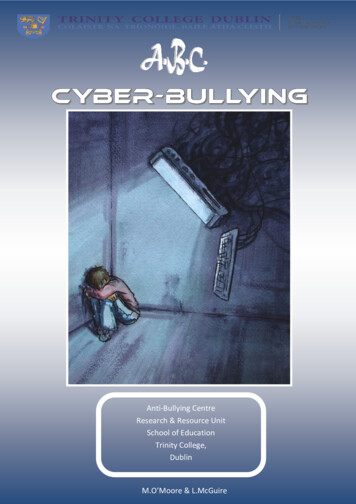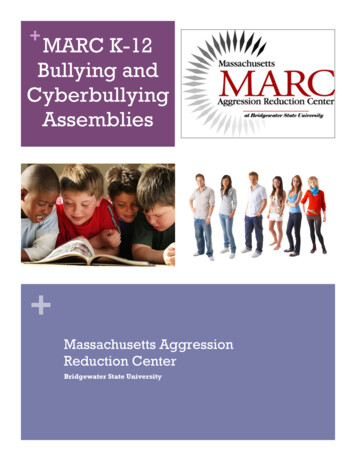
Transcription
MARC K-12Bullying andCyberbullyingAssemblies Massachusetts AggressionReduction CenterBridgewater State University
12All programs utilize up-to-dateresearch findings to maximizetheir effectiveness.Descriptions: MARC K-12 Student Assembly ProgramsPrograms below are listed by age group.We offer programs for all grades, K through 12.Bullying Basics Assembly &Contract (Grades K-1). Aninteractive group presentationdesigned to help childrendevelop the appropriatevocabulary to understand anddeal with bullying issues inschools. Children areintroduced to roles andemotional responses associatedwith bullying. Appropriateways to deal with bullying arediscussed and there is also adiscussion of the differencebetween accidents that mayhappen and bullying. The2presentation ends with an artproject in which studentscolor and decorate a personalcontract that they then sharewith their peers. Contractsshould be displayed in theirclassrooms and utilized asbehavioral cues (not senthome as completed projects).MARC supplies blankcontracts and decorativestickers; the school needs tosupply markers, desks ortables for students and facultymembers to help supervisestudents as they completetheir contracts.
12MARC Student Assembly ProgramsBullying Basics Assembly(Grade 2). During thisinteractive groupassembly, students areintroduced to key conceptsand terms used indiscussing bullying. Thereis a discussion about thedifference betweenconflict and bullying andstudents are presentedwith different scenariosand they are asked toidentify whether thosescenarios are depictingconflict or bullying. Thepresentation alsoencourages students tosupport their peers andalso introduces differentways for students tocombat bullying. Studentsare encouraged,throughout thepresentation, to talk aboutbullying with others andnot to keep it a secret.Bullying & Cyberbullying Basics (Grades3-4). At this interactive assembly webegin to introduce the components ofbullying which are further explained usingage appropriate examples. Students areintroduced to the concepts and rolesassociated with bullying. The differencesbetween conflict and bullying areillustrated to underscore how hurtful anddamaging bullying behaviors can be.Several conflict scenarios and bullyingscenarios are presented to students tohelp them identify future conflict orbullying situations. Some very basic andneutral information about cyberbullying ispresented, such as the concept that usingdisrespectful language toward othersonline can be very damaging andhurtful. We talk about how to cope withdifferent types of bullies and cyberbullies,and how to be a good friend andclassmate. The importance of talking toadults about bullying and cyberbullying isemphasized. Students are encouraged topractice safe behaviors online, such askeeping passwords to themselves andtalking to parents, teachers, or othertrusted adults about the activities they aretaking part in online.3
12 MARC AssembliesBullying and Cyberbullying:What you need to know(Grades 5-6).This assembly is designed tohelp students define andunderstand bullying,cyberbullying, and relationalaggression. Students will gaina clearer understanding of thedifference between fighting orconflict and bullying. Onlinesafety is discussed and real-lifeexamples are presented tohelp illustratethe consequences ofinappropriate onlineactions. Students are educatedabout the dangers of disclosing4too much online, such assending or postinginappropriate photos. Studentswill gain a sense of awarenessabout how serious and hurtfulwords and actions online canbe and that what happensonline may be thereforever. The presentationleaves students with somepractical internet safety adviceas well as concrete ideas of thebest way to with bullies inschool and online.
Middle SchoolBullying andCyber Bullying(Grades 7-8).This assembly approachesissues of bullying, cyberbullying, relational aggression,and Internet the potentialdangers of disclosing too muchonline. Real life examples arediscussed in greater detail, aswe have found these to beparticularly effective with thisage group. It is intended toraise student awareness aboutthe possible consequences ofbullying and cyber bullying foroneself, one’s family, and one’scommunity. Students learn thata “private” online profile isnever truly private. Inaddition, students will gainawareness of the seriousness ofsexting. We will discuss howsomething that might just seemlike a “joke” online could havevery serious consequences.This presentation leavesstudents with realistic internetsafety tips and concrete ideasof how to best deal withbullying and cyberbullyingsituations.5
6Assemblies forHigh School StudentsHigh School Bullying & CyberbullyingAssembly (Grades 9-12).Girls & Cyberbullying Assembly(Grades 6-12).This assembly discusses cyberbullyingand the safe use of technology in greaterdetail than the other student assemblies.There is a growing trend among olderstudents to use technology as a way tobully. The assembly is designed toeducate students about the potentialconsequences of their online behavior onthemselves, their families, and theircommunities. Students are asked to beginthinking about the impression they leavewith others based on their profiles, words,and behavior online. An especiallyimportant point for this age group is todiscuss how their online choices canimpact their future (i.e. collegeacceptance, job opportunities) and theirfriendships. To emphasize the seriousnessof these cyber issues we present real lifeexamples that the students can relate tothroughout the presentation. There aremany misconceptions among this agegroup about online “privacy.” Privacyissues are explored in detail, with anemphasis on social networking sites andsexting. Students are offered advice onhow to handle bullying and cyberbullyingsituations for themselves, their friends,and their classmates.This assembly focuses on the ways thatgirls use cyberspace to facilitaterelational aggression and other cyberproblems. Many conflicts that girls areinvolved in stem from current orformer friendships. The focus of thisprogram is to help girls cope moreeffectively in future bullying orcyberbullying situations as well asgeneral conflict. A female facilitatorleads a girls-only audience (no boysplease) in an interactive presentationand discussion about how cyberbehaviors are changingfriendships. We discuss and offerhealthy ways to handle conflict anddisagreements between friends. Thefemale facilitator involves the audiencein discussing current issues regardingbullying and cyberbullying. Specialattention is given in regards to how tohandle friendship fights or friendshipbreakups, in particular not reactingwhen you are angry or upset. Thisprogram covers current issues thatgirls are dealing with as well asproviding the audience with moreeffective ways to cope and deal withthese types of situations. The assemblydraws from the MARC research ongirls and cyberbullying.
Quisque et ipsum sed arcu convallis fringilla. Ut pede. Nam bibendum semper sem. Sed ipsum mi, imperdiet vel,pharetra tincidunt, aliquet eget, diam. Proin interdum, odio at vestibulum interdum, quam risus facilisis orci, vellacinia nisi nisl at nulla.7
StudentAssemblies The Massachusetts Aggression ReductionBridgewater State UniversityCenterBridgewater, MA 02325http://www.MARCcenter.org
Bullying and Cyber Bullying (Grades 7-8). This assembly approaches issues of bullying, cyber-bullying, relational aggression, and Internet the potential dangers of disclosing too much online. Real life examples are discussed in greater detail, as we have found these to be part
